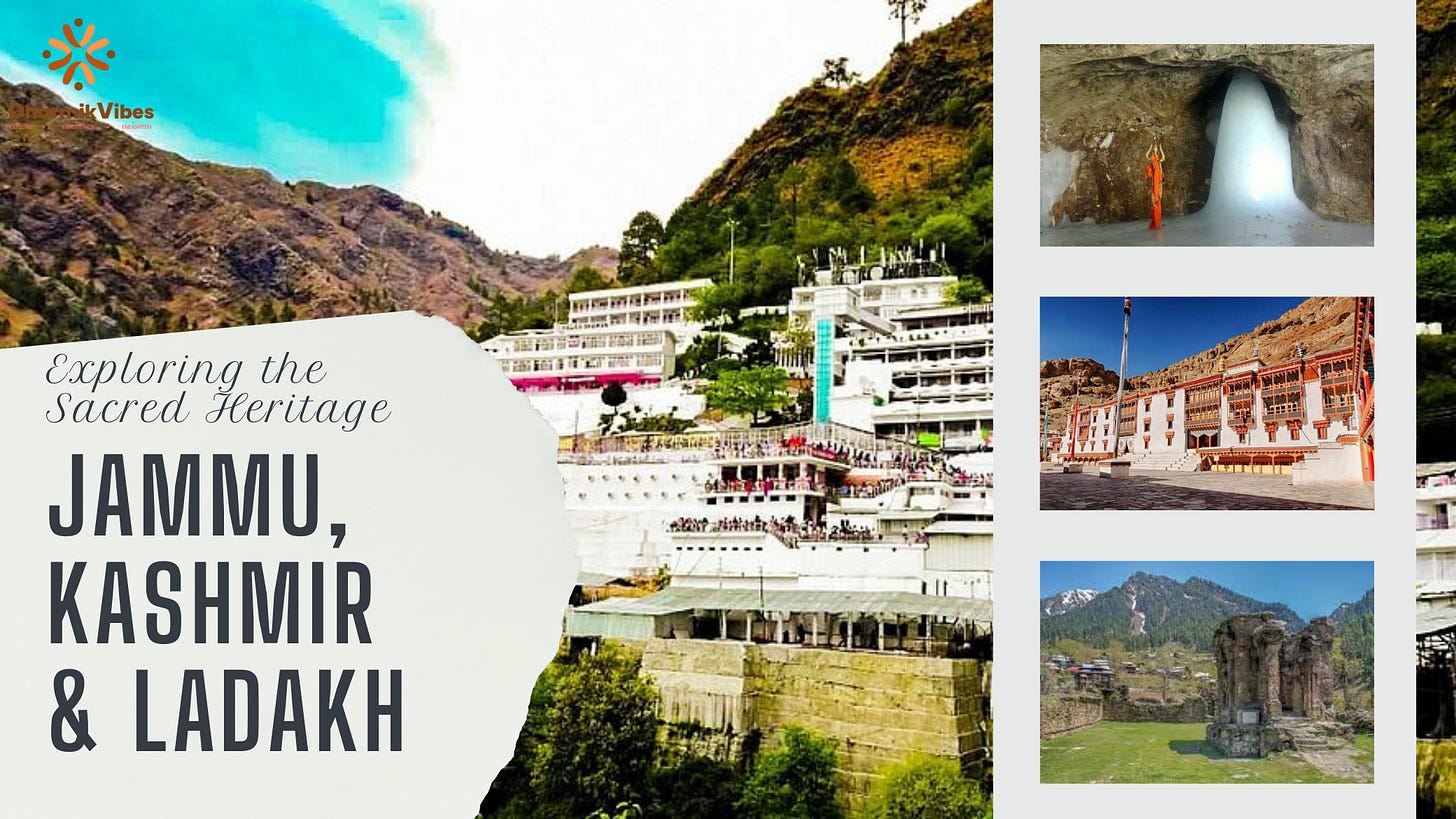Exploring the Sacred Heritage: Religious and Cultural Landmarks of Jammu, Kashmir, and Ladakh
Explore religious & sacred heritage.
Jammu, Kashmir, and Ladakh are known for their breathtaking landscapes, rich cultural history, and deeply rooted spiritual traditions. These regions serve as a confluence of Hinduism, Buddhism & Jainism, creating a unique spiritual fabric woven with ancient temples, monasteries, and sacred sites. This article delves into the diverse religious and cultural landmarks that define these northernmost regions of India, highlighting their historical significance, architectural marvels, and vibrant rituals.
Hindu Temples: The Spiritual Essence of Jammu and Kashmir
Vaishno Devi Temple (Jammu)
One of the holiest shrines in India, the Vaishno Devi Temple, nestled in the Trikuta Hills, attracts millions of devotees annually. Pilgrims undertake a challenging trek to seek the blessings of Goddess Vaishno Devi, making it one of the most revered spiritual journeys in Hinduism.
Amarnath Cave Temple (Kashmir)
Dedicated to Lord Shiva, the Amarnath Cave Temple is famous for its naturally occurring ice Shiva Lingam. Every year, thousands of devotees brave the treacherous Himalayan terrain to participate in the annual Amarnath Yatra, seeking divine blessings.
Raghunath Temple (Jammu)
Built by Maharaja Gulab Singh in the 19th century, Raghunath Temple is a grand structure dedicated to Lord Rama. The temple complex houses several shrines dedicated to Hindu deities and is a hub for devotees in the region.
Sharada Peeth (POK)
Once a renowned center of learning and pilgrimage for Hindus, Sharada Peeth is an ancient temple and university dedicated to Goddess Saraswati. Though it currently lies in Pakistan-occupied Kashmir, it remains an integral part of the Hindu spiritual and cultural heritage.
Buddhist Monasteries: The Tranquil Retreats of Ladakh
Hemis Monastery
The largest and wealthiest monastery in Ladakh, Hemis Monastery is known for its vibrant annual Hemis Festival, dedicated to Guru Padmasambhava. The monastery boasts stunning murals, ancient scriptures, and a grand statue of the Guru.
Thiksey Monastery
Resembling the Potala Palace of Tibet, Thiksey Monastery is an architectural marvel that houses a towering Maitreya Buddha statue. It serves as a center of Buddhist learning and meditation, offering panoramic views of the Indus Valley.
Diskit Monastery
Situated in the Nubra Valley, Diskit Monastery is famous for its 32-meter-tall Maitreya Buddha statue. The monastery provides a serene ambiance for spiritual reflection and exploration.
Alchi Monastery
Unlike other monasteries perched on hills, Alchi Monastery is located on flat ground and is renowned for its exquisite wall paintings and wood carvings that date back to the 11th century.
Jain Temples: The Lesser-Known Spiritual Sites
Jain Temples in Leh
Though lesser-known, Jainism has left its mark in Ladakh with a few temples in Leh, dedicated to Lord Mahavira and other Tirthankaras. These temples serve as important spiritual centers for the Jain community traveling to the region.
Jammu's Jain Temples
Jammu is home to several Jain temples, such as the temples in Raghunath Bazaar, which offer a peaceful retreat for followers of Jainism.
Shankaracharya Temple (Overlooking Srinagar)
Although a Hindu temple, the Shankaracharya Temple also holds significance for Kashmir's Islamic history, as it was once a site of interfaith dialogue and cultural exchanges between Hindus and Muslims.
Sacred Rituals and Festivals
Amarnath Yatra (Hindu pilgrimage to Amarnath Cave)
Hemis Festival (Buddhist festival in Ladakh)
Lohri and Makar Sankranti (Harvest festivals in Jammu and Kashmir)
Sindhu Darshan Festival (A tribute to the Indus River in Ladakh)
Religious Architecture: A Blend of Styles
The temples and monasteries of Jammu, Kashmir, and Ladakh reflect a fusion of architectural influences:
Kashmiri Wooden Temples: Featuring intricate wood carvings and pagoda-style structures.
Ladakhi Monasteries: Built with mud-brick and whitewashed walls, often perched atop cliffs.
Jain and Hindu Temple Structures: Often adorned with idols, frescoes, and shikhara (towering spires).
Religious Travel and Pilgrimage Tourism
Jammu, Kashmir, and Ladakh have emerged as major destinations for religious tourism. With improved infrastructure, connectivity, and government initiatives, pilgrimage tourism is thriving. Travelers can embark on:
Spiritual retreats in Buddhist monasteries
Hindu pilgrimage circuits covering Vaishno Devi, Amarnath, and Raghunath temples
Heritage trails exploring Sufi shrines and Mughal gardens
Jain temple visits in Jammu and Leh
Jammu, Kashmir, and Ladakh offer an unparalleled spiritual experience, blending Hindu, Buddhist and Jain traditions. Whether through the sacred temples of Jammu, the serene monasteries of Ladakh, this region remains a beacon of faith, culture, and history. For travelers and pilgrims alike, exploring these religious and cultural landmarks promises not just a journey through breathtaking landscapes but also a deep connection to the spiritual and architectural heritage of India’s northernmost regions.


